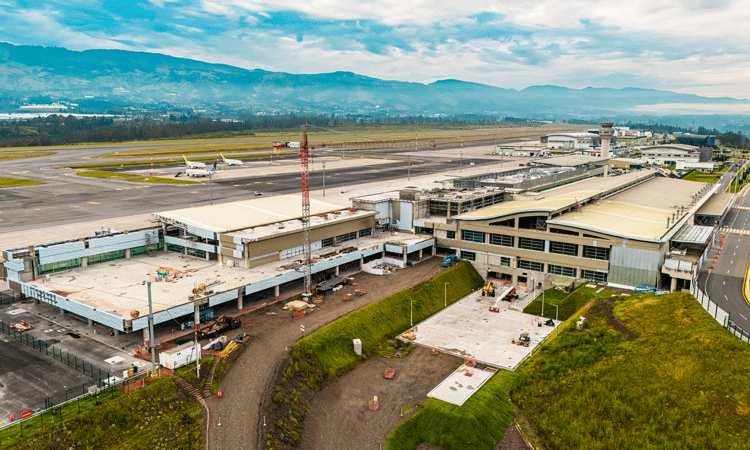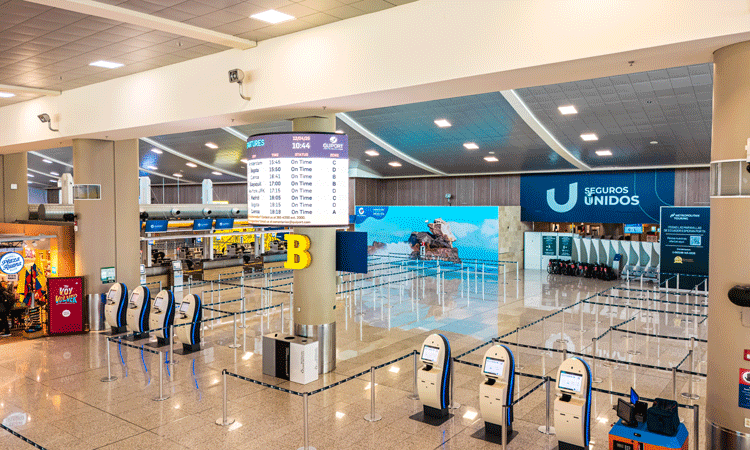Quito International Airport expansion progress after four-year hiatus
Posted: 19 June 2025 | Ramón Miró | No comments yet
Aeropuerto Internacional de Quito’s CEO, outlines to International Airport Review, its expansion progress after halting the project in 2020 due to the pandemic, set to open by the end of 2025.


c: Corporación Quiport
Aeropuerto Internacional de Quito is Ecuador’s busiest airport. Inaugurated in 2013, the airport is currently under an ambitious expansion. It began its expansion in November 2019. However, due to the COVID-19 pandemic, all construction was halted in March 2020.
After a hiatus of over four years, construction resumed in July 2024, with completion anticipated by the end of 2025.
After a hiatus of over four years, construction resumed in July 2024, with completion anticipated by the end of 2025. CEO Ramón Miró expressed confidence in the project’s progress, stating, “With the recovery of passenger flow, we are committed to enhancing the airport’s capacity to meet growing demand.”
Miró also stated that:
Join us live: Shaping the Next Generation of Hold Baggage and Air Cargo Screening
Join us live for an insightful webinar on 11th December at 14:00 GMT, in collaboration with Smiths Detection, as we explore the strategic balance of operational efficiency, regulatory compliance, and sustainability in high-volume security environments.
This session offers a focused look into future-proofing your security strategy.
Key learning points
- Cost Reduction: Strategies to minimize bag travel time while simultaneously reducing operational costs.
- Regulatory Roadmap: Insights into the next wave of regulatory changes and their impact on future investment decisions.
- Sustainable Systems: Practical approaches to building sustainability into security systems and lowering the total cost of ownership (TCO).
- Scalable Solutions: Real-world examples of scalable systems supporting current airport growth and preparing for tomorrow.
Register now for expert insights, case studies, and actionable strategies on operational efficiency!
“The main goal of the expansion project is to strengthen the airport’s operational capacity to accommodate the sustained growth in passenger and aircraft traffic.”
The total investment for the project is US$74.2 million, financed through Quiport’s own resources.
Major terminal and airside upgrades underway
Components of the current project include the expansion of the passenger terminal building by 17,000 square metres of usable space across four levels. This will allow the addition of new commercial and operational areas.
“With this expansion, the passenger processing capacity at the Quiport Airport will increase from five million to seven million passengers per year,” said Miró.
With this expansion, the passenger processing capacity at the Quiport Airport will increase from five million to seven million passengers per year.
The Aircraft parking platform will also gain 35,000m2. High-resistance hydraulic concrete will be used to support the weight of all the aircraft. The new apron is designed to accommodate one Code E aircraft (e.g., Boeing 777, Airbus A350) with a contact position or two Code C aircraft (e.g., Boeing 737, Airbus A320) at remote positions.
“This expansion will enable us to receive more aircraft simultaneously, improve the efficiency of stand allocation, and reduce ground waiting times. It will also support the handling of additional flights during peak hours and make it possible to receive larger aircraft,” said Miró.


C: Corporación Quiport
As of December 2024, around 35% of the project has been completed. It is expected to finish by the end of 2025. With an increase of 25% of terminal space and the addition of new facilities, passengers will benefit greatly. Miró asserts that:
“Passengers will enjoy greater comfort and efficiency thanks to 20 additional airline check-in counters being installed in the international departures area.”
With the new expansion, there will be larger waiting areas, a bigger baggage claim hall, improvements in security and immigration processes, and new dining and shopping options to enrich the travel experience.


C: Corporación Quiport
Sustainable growth at the heart of construction
Measures are also being implemented to ensure the expansion aligns with sustainability and environmental considerations, following Quiport Airport’s objectives to decarbonise its operations by 2035. Construction principles are being applied, including efficient resource use, waste management systems and energy efficiency measures.
Overcoming operational and logistical challenges
The process of an extensive airport expansion is rarely a smooth takeoff, as complications usually arise; Quiport is no exception. Key challenges they have faced include coordinating construction without affecting daily airport operations, managing permits, and controlling costs in the face of inflation. However, these challenges have been overcome through detailed planning, close collaboration with authorities and suppliers, and strict technical supervision.
Miró also notes that another major challenge is:
“Strengthening the health and safety culture in the workplace. Our standards in this area are high, as mandated by our shareholders, and the challenge lies in ensuring that these standards are embraced by the main contractors and subcontractors, so they adopt our occupational health and safety culture.”
The expansion will have a great impact on the local community. The economic development of the region and the creation of jobs will soar as a result. Approximately 8,000 people work at Quiport Airport across various private companies and public entities. Of those, 30% live in nearby parishes.


C: Corporación Quiport
Driving regional development and community impact
“The expansion will generate direct and indirect jobs during both the construction phase and future operations, energising sectors such as construction, retail and services. It will also boost tourism and strengthen connectivity, contributing to regional economic growth,” said Miró.
The Airport has also planned and implemented strategies to minimise disruptions to current airport operations during the construction phase.
One method was to make the construction area clearly separated from operational areas, both in the terminal and on the apron, to avoid any impact with airport operations. Additionally, the airport also maintains constant communication with airlines, commercial operators and users to inform them of any changes or potential impacts.
“Our main focus has been to ensure continuous service with minimal disruptions to the passenger experience, which is one of Quiport’s strategic pillars in airport management,” said Miró.


Prior to leading Quiport, he was President of HAS-DC, a Houston-based pioneer in Latin American airport investment and consultancy. He is a strong advocate for public-private partnerships and has a background in corporate finance and the energy sector.
Miró holds an Engineering degree from Trinity University, an MBA from Northwestern University’s Kellogg School, and is certified as an International Airport Professional (IAP) through the ACI/ICAO AMPAP programme.
Stay Connected with International Airport Review — Subscribe for Free!
Get exclusive access to the latest airport and aviation industry insights from International Airport Review — tailored to your interests.
✅ Expert-Led Webinars – Gain insights from global aviation leaders
✅ Weekly News & Reports – Airport innovation, thought leadership, and industry trends
✅ Exclusive Industry Insights – Discover cutting-edge technologies shaping the future of air travel
✅ International Airport Summit – Join our flagship event to network with industry leaders and explore the latest advancements
Choose the updates that matter most to you.
Sign up now to stay informed, inspired, and connected — all for free!
Thank you for being part of our aviation community. Let’s keep shaping the future of airports together!
Related topics
Airport construction and design, Airport development, Capacity, Funding and finance, Parking, Passenger experience and seamless travel, Passenger volumes, Sustainable development, Terminal operations, Tourism, Workforce


















